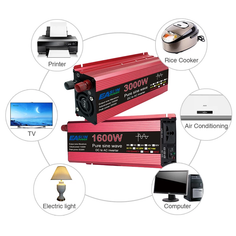In the realm of renewable energy, the high frequency pure sine wave inverter for efficient conversion stands out as a pivotal component. These inverters are designed to convert direct current (DC) into alternating current (AC) with remarkable efficiency, making them essential for various industrial applications. But what exactly makes these inverters so effective?

Understanding High Frequency Pure Sine Wave Inverters
A high frequency pure sine wave inverter operates by utilizing high-frequency switching technology. This method allows for a more compact design and improved efficiency compared to traditional inverters. The output waveform closely resembles a pure sine wave, which is crucial for powering sensitive electronic devices without distortion.
"High frequency inverters are not just about efficiency; they also ensure the longevity of connected devices." — Energy Solutions Expert
Key Advantages of High Frequency Pure Sine Wave Inverters
- Efficiency: These inverters typically achieve higher efficiency rates, often exceeding 90%, which translates to lower energy costs.
- Compact Design: The high-frequency operation allows for smaller components, making installation easier and saving space.
- Clean Power Output: The pure sine wave output is essential for sensitive equipment, reducing the risk of damage.
- Versatility: They can be used in various applications, from solar energy systems to industrial machinery.
Applications in Industrial Settings
The high frequency pure sine wave inverter for efficient conversion is widely used in industrial environments. Industries such as manufacturing, telecommunications, and renewable energy rely on these inverters for their operations. For instance, in solar energy systems, they convert the DC generated by solar panels into AC, which can be used to power machinery or fed back into the grid.
Moreover, these inverters are integral in backup power systems, ensuring that critical operations continue during power outages. Their ability to provide stable and reliable power makes them indispensable in maintaining productivity.
Choosing the Right High Frequency Pure Sine Wave Inverter
When selecting a high frequency pure sine wave inverter for efficient conversion, consider the following factors:
- Power Rating: Ensure the inverter can handle the total wattage of your equipment.
- Efficiency Rating: Look for inverters with high efficiency to maximize energy savings.
- Features: Some inverters come with additional features like remote monitoring and built-in protections.
For example, the XYZ High Frequency Inverter offers a robust design with a 95% efficiency rating, making it an excellent choice for industrial applications.
Conclusion
In conclusion, the high frequency pure sine wave inverter for efficient conversion is a vital technology in today's industrial landscape. Its efficiency, compactness, and clean power output make it a preferred choice for various applications. As industries continue to evolve towards sustainable energy solutions, understanding and implementing these inverters will be crucial for future success.
For more insights, check out this informative video on high frequency inverters.
